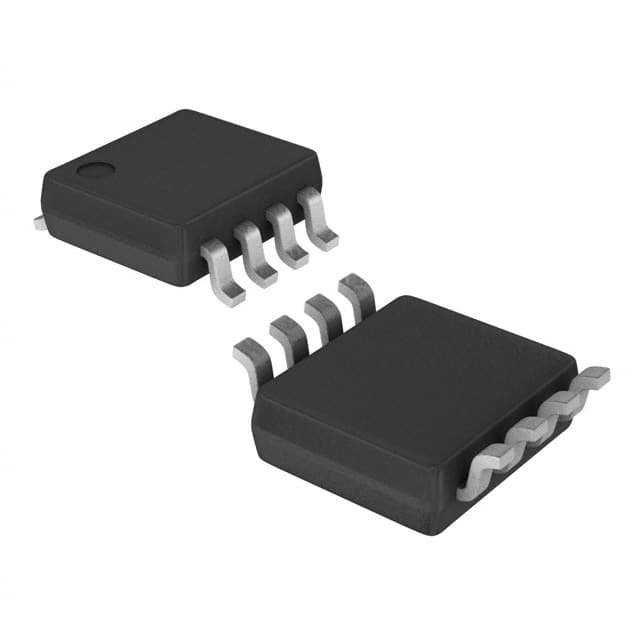Lihat spesifikasi untuk detail produk.

DAC8560IADGKTG4
Product Overview
Category: Digital-to-Analog Converter (DAC)
Use: The DAC8560IADGKTG4 is a high-performance, 16-bit digital-to-analog converter designed for precision industrial applications. It converts digital input signals into analog output voltages with exceptional accuracy and linearity.
Characteristics: - High resolution: 16-bit resolution provides precise control over the analog output. - Low noise: The DAC offers low noise performance, ensuring accurate signal reproduction. - Fast settling time: The device settles quickly to the desired output voltage, enabling rapid response in dynamic applications. - Wide operating temperature range: The DAC operates reliably across a wide temperature range, making it suitable for harsh industrial environments.
Package: The DAC8560IADGKTG4 comes in a small form factor, 8-pin VSSOP package, which allows for easy integration into space-constrained designs.
Essence: The essence of the DAC8560IADGKTG4 lies in its ability to convert digital signals into precise analog voltages, providing a crucial interface between digital control systems and analog devices.
Packaging/Quantity: The DAC8560IADGKTG4 is typically available in reels of 2500 units per reel.
Specifications
- Resolution: 16 bits
- Output Voltage Range: 0V to Vref
- Reference Voltage Range: 2.5V to 5.5V
- Supply Voltage Range: 2.7V to 5.5V
- Operating Temperature Range: -40°C to +125°C
- Integral Nonlinearity (INL): ±1 LSB (max)
- Differential Nonlinearity (DNL): ±0.5 LSB (max)
- Settling Time: 10 µs (typ)
- Power Consumption: 0.5 mW (typ)
Pin Configuration
The DAC8560IADGKTG4 features the following pin configuration:
- VDD - Supply voltage
- VREF - Reference voltage input
- AGND - Analog ground
- OUT - Analog output voltage
- DIN - Digital input data
- SCLK - Serial clock input
- SYNC - Chip select input
- DGND - Digital ground
Functional Features
- High-resolution digital-to-analog conversion
- Low noise and high linearity for accurate signal reproduction
- Fast settling time for dynamic applications
- Wide operating temperature range for industrial environments
- Serial interface for easy integration with microcontrollers or digital systems
Advantages and Disadvantages
Advantages: - High resolution provides precise control over analog output. - Low noise performance ensures accurate signal reproduction. - Fast settling time enables rapid response in dynamic applications. - Wide operating temperature range makes it suitable for harsh industrial environments.
Disadvantages: - Limited output voltage range compared to some other DACs. - Requires an external reference voltage source.
Working Principles
The DAC8560IADGKTG4 utilizes a string of resistors to convert the digital input data into an analog output voltage. The digital input data is provided through the DIN pin, and the serial clock input (SCLK) and chip select input (SYNC) signals control the conversion process. The device uses an internal reference voltage (VREF) to determine the output voltage level.
Detailed Application Field Plans
The DAC8560IADGKTG4 finds applications in various fields, including: - Industrial automation and control systems - Test and measurement equipment - Audio processing and synthesis - Motor control systems - Programmable logic controllers (PLCs) - Data acquisition systems
Detailed and Complete Alternative Models
- DAC8564IADGKT: 16-bit, quad-channel digital-to-analog converter
- DAC8562IADGKT: 16-bit, dual-channel digital-to-analog converter
- DAC8568IADGKT: 16-bit, octal-channel digital-to-analog converter
- DAC8571IPW: 16-bit, single-channel digital-to-analog converter with parallel interface
These alternative models offer similar functionality and performance to the DAC8560IADGKTG4, but with different channel configurations or interface options.
Word count: 533 words
Sebutkan 10 pertanyaan dan jawaban umum terkait penerapan DAC8560IADGKTG4 dalam solusi teknis
Sure! Here are 10 common questions and answers related to the application of DAC8560IADGKTG4 in technical solutions:
Q: What is the DAC8560IADGKTG4? A: The DAC8560IADGKTG4 is a digital-to-analog converter (DAC) integrated circuit that converts digital signals into analog voltages.
Q: What is the resolution of the DAC8560IADGKTG4? A: The DAC8560IADGKTG4 has a resolution of 16 bits, allowing for precise control over the output voltage levels.
Q: What is the operating voltage range of the DAC8560IADGKTG4? A: The DAC8560IADGKTG4 operates from a single power supply voltage range of 2.7V to 5.5V.
Q: How many channels does the DAC8560IADGKTG4 have? A: The DAC8560IADGKTG4 has 4 independent channels, which can be used simultaneously or individually.
Q: What is the output voltage range of the DAC8560IADGKTG4? A: The DAC8560IADGKTG4 supports a programmable output voltage range of 0V to Vref, where Vref is the reference voltage.
Q: Can the DAC8560IADGKTG4 operate in both unipolar and bipolar modes? A: Yes, the DAC8560IADGKTG4 can be configured to operate in either unipolar mode (0V to Vref) or bipolar mode (-Vref/2 to +Vref/2).
Q: What is the maximum settling time of the DAC8560IADGKTG4? A: The DAC8560IADGKTG4 has a maximum settling time of 10µs, ensuring fast and accurate voltage outputs.
Q: Can the DAC8560IADGKTG4 be controlled using a serial interface? A: Yes, the DAC8560IADGKTG4 supports both SPI (Serial Peripheral Interface) and I2C (Inter-Integrated Circuit) communication protocols.
Q: What is the temperature range in which the DAC8560IADGKTG4 can operate? A: The DAC8560IADGKTG4 can operate within a temperature range of -40°C to +105°C, making it suitable for various environments.
Q: What are some typical applications of the DAC8560IADGKTG4? A: The DAC8560IADGKTG4 is commonly used in industrial automation, process control, motor control, test and measurement equipment, and audio systems.
Please note that these answers are general and may vary depending on specific implementation requirements.

